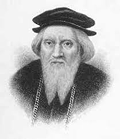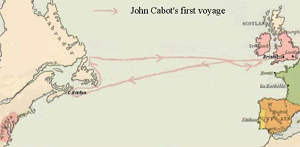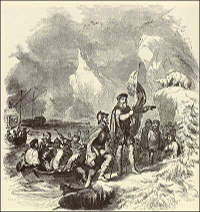The Explorer John Cabot
John Cabot was the first sailor in English employ to reach the New World. He did so in 1497. 
Cabot was not an Englishman but an Italian man, born in Genoa (the home of Christopher Columbus) in 1450. Cabot moved to Venice in the 1460s and became a citizen of that city in 1476. The son of a spice merchant, he made a living as a spice trader. He also took his trade seriously, studying navigation and mapmaking. Like Columbus, Cabot was interested in going east by going west–reaching Asia by sailing across the Atlantic Ocean. The story of Cabot's life has gaps in it for several years. He is known to have married a woman named Mattea, with whom he eventually had three sons, named Ludovico, Sancto, and Sebastiano. Venetian records show that he left in 1488, unable to pay his debts. He is thought to have lived in Spain for a time; some records asserts that he oversaw a bridge-building project for a time in Valencia. He is known to have been in Bristol, England, in 1495. Bristol was a port city from which other across-the-Atlantic expeditions had begun. 
Cabot obtained royal permission, from King Henry VII, to sail in 1496, on the condition that he bring something back to sell at English markets. Cabot quickly agree and made final preparations. It took longer than intended, but Cabot finally left Bristol in May 1497, captaining a crew of 18 (including his son Sebastian) aboard the ship Matthew. He sailed across the northern Atlantic Ocean and reached North America a month after he left, on June 24. Where he arrived is still open to discussion by scholars. Among the landfall candidates are Cape Breton Island, Labrador, and Newfoundland. 
Wherever he really was, Cabot set about claiming things for England. After a brief bilateral exercise of hoisting both English and Venetian flags, he set about naming islands and bodies of water: England's Cape, Island of St. John, St. George's Cape, Trinity Islands. What is today known as Cabot Strait is a 60-mile-wide channel that runs between Cape Breton Island and Newfoundland. Cabot didn't stay long and made it back across the Atlantic to report back to the king who had hired him that he had indeed reached the northeast coast of Asia. The king gave Cabot a reward and urged him to make another voyage. Cabot left again the following year and wasn't heard from again. His goal on this second voyage was to reach Japan, which was then known as Cipangu (spelled various ways). Cabot set off about a year after his first voyage, so in May 1498, with five ships and 200 men. One ship sought anchorage in Ireland in July; none of the other ships was seen again. Nor was Cabot. Some reports have him in England in 1499 or 1500, suggesting that he survived what would have been trouble at sea. Other reports included mention of a Christian priest who accompanied Cabot on this second mission making it to what is now Newfoundland and setting up a settlement there. |
|
Social Studies for Kids
copyright 2002–2025
David White




